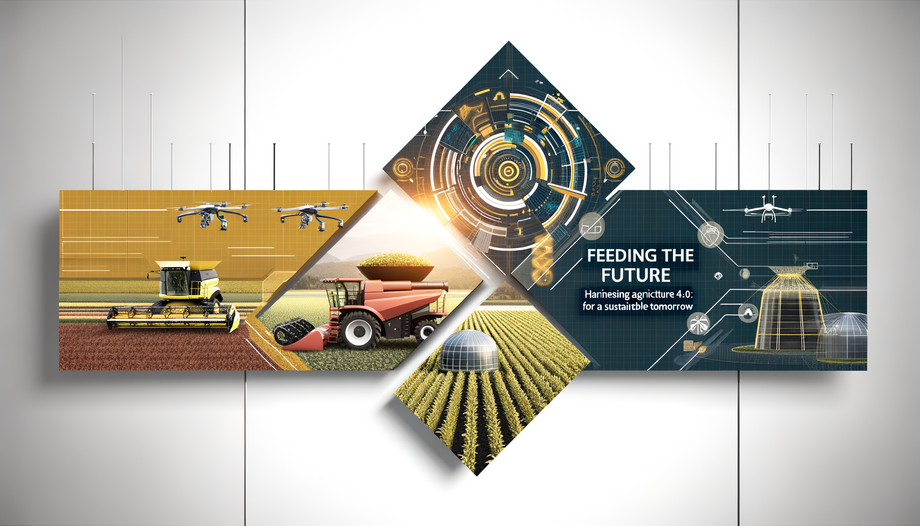In the ever-evolving landscape of global agriculture, the urgency for innovative solutions has never been greater. With the world population projected to reach nearly 10 billion by 2050, the current agricultural systems confront an unprecedented challenge: sustainably meeting the soaring global demand for food. Enter Agriculture 4.0, a transformative strategy leveraging technology to reshape agriculture as we know it. In this article, we'll explore the intricacies of Agriculture 4.0 and how it tackles the challenges of an increasing global population.
A New Era: Agriculture 4.0
Agriculture 4.0 is the convergence of advanced technologies into farming practices, paving the way for more sustainable, efficient, and productive food systems. Digitalization in agriculture has seen the integration of IoT (Internet of Things), AI (Artificial Intelligence), blockchain, and drones—all poised to revolutionize the agri-food sector.
1. IoT: Sowing the Seeds of Efficiency
IoT is reshaping the way farmers perceive and interact with their fields. Smart sensors placed across farms can monitor key variables such as soil moisture, pH levels, and atmospheric conditions in real-time. This wealth of data allows farmers to tailor their actions—for example, deciding the optimal time for watering crops, a crucial move to increase water efficiency while preventing over-irrigation.
Such precision farming techniques have the potential to enhance resource management, reduce input waste, and ultimately increase productivity—a necessity as farmland becomes scarce and climate change challenges traditional practices.
2. AI: Predicting and Optimizing for Better Yields
Artificial Intelligence uncovers insights from vast amounts of agricultural data that might otherwise remain hidden. This powerful tool analyses seed data, weather forecasts, and previous crop performances to make informed decisions on planting and harvesting.
AI-driven predictive analytics help farmers foresee potential issues, like pest infestations or disease outbreaks, even before they occur. Implementing AI reduces response times, curbing yield losses while promoting low-impact agricultural practices.
3. Blockchain: Ensuring Transparency in the Food Supply Chain
Blockchain technology introduces an immutable ledger that can foster trust and accountability throughout the supply chain. From the moment a seed is sown to when the product reaches the retailer's shelf, each transaction is securely recorded.
This traceability ensures food safety, reduces fraud, and assures consumers of the origins and quality of their food. Additionally, blockchain's transparency helps minimize logistical inefficiencies, reducing food wastage—a critical factor in both improving food security and satisfying global demand.
4. Drones: Revolutionizing Field Operations
Drones are the new eyes in the sky, enabling farmers to survey crops deep into vast fields quickly. By capturing multi-spectral images, drones assess crop health, identify stressors, and validate input applications like fertilizers or pesticides.
With swift and accurate aerial assessments, farmers can precisely analyze field conditions, paving the way for more efficient resource utilization and substantial cost savings. Coupled with GPS technology, drones offer a bird's-eye perspective that drastically improves farm management.
Meeting the Growing Hunger: Agriculture 4.0 Innovations
Emerging from the technological landscape are a myriad of innovations aimed at confronting food shortages and ensuring sustainable agricultural practices.
- Hydroponics and Vertical Farming: Hydroponics allows growers to cultivate plants without soil, using nutrient-rich solutions. Vertical farming stacks these systems, maximizing urban space utilization. By minimizing land usage and water consumption, these solutions present an appealing answer to future food shortages.
- Biotechnology and Genetically Modified Crops: Advances in genetic engineering have contributed to developing crop varieties with improved yields, pest resistance, and climate adaptability. These biotechnological breakthroughs are pivotal in bolstering global food production.
- Microbial Crop Enhancers: Nature's own microorganisms promote plant growth by enhancing nutrient uptake and fighting pathogens. These eco-friendly fertilizers minimize dependency on synthetic chemicals—ushering in a greener agricultural paradigm.
Challenges and the Road Ahead
Despite the promise of Agriculture 4.0, several hurdles exist. High costs of technology adoption, digital literacy barriers, and data privacy concerns persist as major blockers. However, collaboration among stakeholders and policy incentives can bridge these gaps.
The solution lies in investing in:-
- Education and Training: Empowering farmers with digital skills and resources to adeptly utilize technology effectively.
- Public-Private Partnerships: Leveraging synergies to fund research, innovation, and implement scalable solutions.
- Robust Infrastructure: Ensuring access, connectivity, and reliability—especially in remote regions crucial to food production.
Conclusion
Agriculture 4.0 ushers in a frontier where technology ceaselessly pioneers the path towards a sustainable food system. By harnessing the power of innovation, we can transform agriculture to meet the challenges posed by a growing global population. The time is now for stakeholders to collaboratively innovate, invest, and cultivate the tools necessary to feed the world—not just today, but for generations yet to come.

